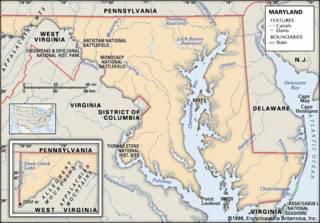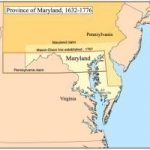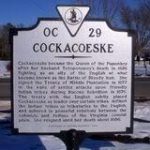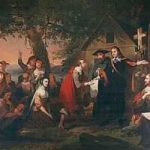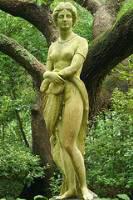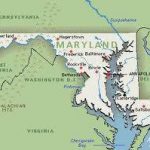Maryland Indian Tribes
The first Marylanders were Paleo-Indians who came more than 10,000 years ago from other parts of North America to hunt mammoth, great bison, and caribou. By 1000 B.C., Maryland had more than 8,000 Native Americans in about 40 different tribes. Most of them spoke Algonquian languages. They grew corn, peas, squash and tobacco. They also hunted, fished and traded with tribes as far away as New York and Ohio.
The word Chesapeake, as in Chesapeake Bay, came from the Native American word “Chesepiuk,” an Algonquian name for a village that the Roanoke, Virginia, colonists discovered in 1585 near the mouth of the Bay. Later, mapmakers used the word to name the Bay. People have said that Chesapeake means great salt water or great shellfish bay, but no records exist to verify those definitions.
In 1608, Captain John Smith thought there was “no place more perfect for man’s habitation” than the Chesapeake Bay. Fur trader William Claiborne thought so, too, and set up a fur trading post on Kent Island in 1631. This was the first English settlement in the upper Chesapeake.
In 1632, King Charles I of England granted a land grant to George Calvert, the first Lord Baltimore, to form a colony north of the established Virginia Colony. The colony would be named Maryland in honor of King Charles’ wife Queen Henrietta Maria. The first settlement in Maryland was at St. Mary’s on the Potomac River on the western shore of the Chesapeake Bay in 1634.
The boundary of the grant included all of present day Maryland and Delaware, and included all of the homeland of the Nanticokes, the Piscataway/ Conoy and parts of many other tribal homelands including the Lenape, Powhatan, Susquehannock, Shawnee and others.
The Piscataway
A tribe of Algonquian linguistic stock formerly occupying the peninsula of lower Maryland between the Potomac River and Chesapeake Bay and northward to the Patapsco, including the present District of Columbia, the Piscataway are notable as being the first tribe whose Christianization was attempted by the English.
Under the Maryland Government, the other chiefs or kings all recognized the chief of Piscataway as their emperor, and their original population was probably nearly 2500.
On March 25, 1634, the Catholic English colony of Lord Baltimore, including the Jesuit fathers Andrew White and John Altham, landed on St. Clement’s Island and established friendly relations with the natives and the great chief of Piscataway and the chief of Potomac town on the Virginia side. The first altar was set up in an Indian wigwam.
Because of attacks by the powerful Susquehannock at the head of the bay, the local natives were about to move, and the English settlers bargained with them for the abandoned site.
Under the new Government, the Piscataway rapidly declined. Driven from their best lands by legal and illegal means, demoralized by liquor dealers, hunted by slave-catchers, wasted by smallpox, constantly raided by the powerful Susquehannock while forbidden the possession of guns for their own defense, their plantations destroyed by the cattle and hogs of the settlers, and their pride broken by oppressive restrictions, they sank to the condition of helpless dependents whose numbers constantly diminished.
In 1666, they addressed a pathetic petition to the assembly: “We can flee no further. Let us know where to live, and how to be secured for the future from the hogs and cattle.” Reservations were soon established for the twelve villages then occupied by them.
Encroachments continued, however, and the conquest of the Susquehannock by the Iroquois in 1675 only brought down upon the Piscataway a more cruel and persistent enemy. In 1680, nearly all the people of one town were massacred by the Iroquois, who sent word to the assembly that they intended to exterminate the whole tribe. Peace was finally arranged in 1685.
In 1697, the emperor and principal chiefs, with nearly the entire tribe, abandoned their homes and fled into the backwoods of Virginia. At that time, they numbered under 400, and this small remnant was further reduced by a wasting epidemic in 1704.
Refusing all offers to return, the Piscataway negotiated with the Iroquois for a settlement under their protection, and began a slow migration northward. After their removal to the north they were known as the Conoy, a corruption of their Iroquois name.
They stopped for long periods at various points along the Susquehanna River until 1765, when they were found living with other remnant tribes at or near Chenango (now Binghamton, New York) and numbering only about 120 souls. From there, they drifted west with the Delaware and made their last appearance in history at a council at Detroit in 1793.
The Accohannock
The Accohannock Tribe is one of the oldest tribes in Maryland. The Accohannocks originally inhabited the territory they called Accomack, which became the Eastern Shore of Old Virginia and is presently the Eastern Shore of Maryland and Virginia. The territory villages on the Annemessex River, on the Accohannock Creek in Virginia, and on the islands in the Chesapeake Bay.
The Accohannock strive to preserve and promote their history, language, traditions, and culture, to foster the education, health, social, and economic well-being of individuals and the tribal community, with trust and integrity.
The Accohannock are an Algonquian-speaking sub-tribe of the Powhatan Nation. They were the first watermen, hunters, farmers, and trappers on the Chesapeake Bay waters and wetlands. They harvested food from the Chesapeake Bay and its many tributaries. They grew squash, maize (corn), and were great hunters of waterfowl, deer, rabbit, squirrel, raccoon, bear, and elk.
Unlike many Native Americans who fought the white settlers, the Accohannock managed to build a strong relationship with the colonists. Rapid changes in colonial policy beginning in the 1640s caused much dispersion and assimilation, which weakened the culture. The Chief and the government were forced to cede all authority and lands to the King of England and his representatives. With the loss of its land, self-government, and other aspects of their lives were destroyed.
After Chief Powhatan died, his brother, Opechancanough, took over his chiefdom. He hated the white man, and developed a plan to poison their food and water. The Accohannock were encouraged to participate, but they refused, and warned the colonists of Opechancanough’s plan. The plan failed, and Opechancanough rejected the Accohannock Tribe.
In 1659, the Maryland Accohannock’s name was changed to Annemessex, the name of the river where they lived. According to oral tradition, the Clan Mothers prayed for peace and survival and received a vision to follow Pocahontas, to marry their daughters to the white colonists in order to hide in plain sight, and to preserve the tribal bloodlines until the tribe could be reborn. Clan names survive today and many of the tribe’s people live in the same area as those who originally inhabited Maryland.
The Nanticoke and the Choptank
On what is now known as the Eastern Shore lived the Algonquian tribes, the Nanticoke and Choptank. They were Tidewater people, living along the rivers that now bear their names. Although these Indians were traders rather than fighters, the Nanticokes on several occasions proved hostile to the settlers.
Homes
These native peoples lived in domed shaped homes called wigwams. These homes were made from the framework of branches and saplings driven into the ground and tied down with vines and hide strips. The outside frames were covered with sheets of tree bark, such as cedar, or woven bulrush mats. In the center of the earthen floor, fire hearths were built to provide warmth. A hole in the roof allowed smoke to escape.
Tribes lived in seasonal villages, where groups of wigwams were built. Larger dwellings for council meetings and tribal gatherings were called longhouses. Sweat lodges were made for physical and spiritual cleansing, but in warmer months baths were taken in the clear rivers. Villages were sometimes surrounded by log fences for protection from enemy tribes.
Women
Native American women of the Eastern Woodlands region fashioned clothing from animal skins and furs for warmth. Decorations and jewelry were made from shells and quills. Some tribes tattooed or painted their skin using berries. Later, after European contact, eastern tribes traded furs for cooler cotton fabrics called trade cloth, and decorated them with ribbon strips of fabric, making ribbon shirts and dresses. Moccasins, made of deerskin, served as traditional native footwear, because they were soft and comfortable.
Culture
The Nanticoke enjoyed the best of native lifestyles. They were proficient farmers. By this time, Eastern Shore Indians were planting corn and beans, and drying them for later use. Women and children cared for lush gardens of corn, beans, squash, pumpkins, sunflowers, and tobacco. They gathered nuts, berries, birds’ eggs, and edible plants in season.
Since they lived close to the rivers, in warmer months, they dined on delicious seafood, including clams, oysters, mussels, crabs, eels, and fish. Nets, snares, baskets, and spears were fashioned by the men to harvest the water’s bounty. The men hunted the forests and meadows of the Eastern Shore for squirrels, turkeys, deer, opossums, rabbits, bear, partridges, ducks and geese.
Food was roasted over open fires or boiled in clay pots as a stew. Bows, arrows, and spears were used for larger game and snares or traps were set for smaller animals. All parts of the animals and sea creatures were utilized. Shells were used for spoons, bowls, wampum, and ornate decorations. Porcupine quills, furs, skins, sinew, and bones were used for clothing and tool implements.
First Contact
The first contact with the Nanticoke Tribe was recorded by Captain John Smith in 1608. While exploring the Chesapeake Bay, Smith and his crew sailed onto the Kuskarawaok River. The Kuskarawaoks, later known as the Nanticoke, cautiously watched Smith’s ship from the shore, climbing into the trees for a better look. When Smith approached the shore in a boat, the Nanticoke shot arrows at them. Smith prudently withdrew to the main boat and anchor for the night in the middle of the river.
The next morning, the Nanticoke appeared on the shore with baskets of food. Still cautious, Captain Smith had his men fire muskets over the heads of the Nanticoke. The Indians escaped. Not until then did Smith’s landing party see warriors lying in the reeds set for an ambush. Later that afternoon, with the Indians were gone he and his men came ashore. The party found fires still burning but no Indians. Smith discovered glass beads, shells, and copper pieces left as gifts of friendship.
The following day, four natives who had been fishing in a canoe approached Smith’s ship. The captain convinced them that he came in friendship and they later returned with twenty villagers. In time food, water, and furs were exchanged for gifts and supplies that the English had. Several Nanticokes agreed to serve as guides for Smith to continue his exploration of the Kuskarawaok, now known as the Nanticoke River.
Captain Smith recorded that nearly 200 warriors lived with their families on the Nanticoke River, making their tribe more significant in population than many other tribes residing on the Eastern Shore at that time. The Nanticoke were allied with the Powhatan Confederacy in what is now Virginia. Such alliances allowed smaller bands of Indians to have protection from enemy tribes.
The 17th Century
At the end of the 17th Century, the Nanticoke and the Choptank were the only native tribes still living on the Eastern Shore of Maryland, thereby surviving 70 years of conflict and contact with European settlers. As the numbers of settlers increased, the Nanticoke’s traditional hunting and farming was disrupted.
Records show that colonists complained that the Nanticoke and other tribes tried to add to their diet by stealing a few hogs and cattle from the settlers. However, the increase of colonists and the decrease in forests had severely depleted the supply of game. Although colonial authorities tried at first to protect the Indians traditional existence, both the settlers and traders ignored the local government’s suggestions for co-existence with the native people.
Unfairly treated, and their way of life severely restricted, the Nanticoke and other natives tried to protect themselves through raids and threats of war. Unfortunately, in 1642 and again in 1647, Maryland Governor Thomas Greene ordered Captain John Pike of the militia, to attack and destroy the Nanticoke village and gardens to force them out of the area.
The first of five treaties were signed in 1668 by Chief Unnacokasimmon to establish peace between Maryland and the Nanticoke, but the treaties were unfair. Settlers continued to illegally seize the lands of the Nanticoke and other tidewater tribes. Eventually, the Nanticoke and the Choptank asked Maryland authorities to grant them specific tracts of land.
The Reservations
In the early 18th Century, the Maryland Assembly set aside 3000 acres for three reservations. This helped at first, but it disrupted the seasonal hunting of the Nanticoke, who needed to travel between their traditional winter hunting grounds and their spring and summer farming and fishing sites. Remaining year round on the reservation severely restricted food and shelter. Traditionally, Indians moved away from the shores and went inland before the cold of winter came.
Furthermore, Maryland authorities included a stipulation that the only way the Nanticoke could legally retain reservation lands was if they agreed not to leave. Again, the Nanticoke leaders petitioned the authorities for temporary permission to leave during winter months to hunt.
Finally, Maryland authorities agreed, but when the Nanticoke returned the following spring, they found homesteads on their land, built by squatters who assumed ownership by right of occupancy. Trespassers also destroyed reservation land by harvesting large amounts of timber.
Eventually, the Nanticoke decided to form a legal organization. By 1881, the Nanticoke Tribe was recognized by the state as a legal entity. In 1921, the Nanticoke formed the Nanticoke Indian Association, which was granted non-profit status.
SOURCES
Maryland
Piscataway Indians
Maryland Indian Tribes
History of Maryland
The Nanticoke Indian Tribe
Exploring Maryland’s Roots
When Indians Lived in Our Land
